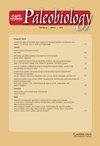美国阿拉巴马州晚白垩世胎生动物的形态分析:性双态性、异形性及对分类学的影响
IF 2.7
2区 地球科学
Q2 BIODIVERSITY CONSERVATION
引用次数: 0
摘要
传统的类型学分类方法往往不能充分考虑种内变异,可能导致分类过度。对于包括胎盘虫属在内的许多类群来说,近期研究中记录的种内变异(如本体变化、性二形、多态性)对历史上物种名称的扩散提出了挑战。在这里,我们采用了种群分类方法,并定量评估了阿拉巴马州和邻近县的晚白垩世(山东安-坎帕尼亚)胎生动物样本的形态计量变异。我们使用线性混合模型(LMMs)来描述形态变量如何随海螺大小的变化而变化,利用混合纵向数据来评估个体的生长变化,并为多变量分析的解释提供信息。结合地质构造的扩展 LMM 评估了形态随时间的变化。然后使用主成分分析和聚类分析来评估多元形态空间中出现的独立聚类的数量,这些聚类与以前的分类群名称分配无关。多变量空间中不连续的缩放关系和独特的聚类表明,性二态的特点是成体大小不同,其次是形状不同。之前的 Stantonoceras 和 Placenticeras 分类在我们的形态空间中大致重叠,无法证明这种历史性的区分(作为性二型或作为属或亚属)是合理的。Placenticeras 的海螺形态和装饰物位置随着时间的推移而发生变化,这表明其在粗略(阶段级)生物地层学方面具有潜在的实用性。然而,时间上的变化与形态空间上的明显分组并不相关,我们的数据也无法支持大量的物种名称报告。我们的样本(代表 130 年的采集工作)中可能只有一到两个(连续的)物种。除了强调对胎盘虫属进行重大分类修订的必要性之外,本研究还证明了 LMMs 在区分形态变异的不同来源、改进种群分类方法下的形态空间解释以及最大限度地利用非破坏性方法获取本体发育信息方面的实用性。本文章由计算机程序翻译,如有差异,请以英文原文为准。
Morphometric analysis of the Late Cretaceous Placenticeras of Alabama, USA: sexual dimorphism, allometry, and implications for taxonomy
A traditional typological approach to taxonomy often does not adequately account for intraspecific variation and can result in taxonomic oversplitting. For many groups, including ammonoids of the Placenticeras genus, intraspecific variation documented in recent studies (e.g., ontogenetic changes, sexual dimorphism, polymorphism) challenges the historic proliferation of species names. Here, we used a population approach to taxonomy and quantitatively evaluated morphometric variation in a sample of Late Cretaceous (Santonian–Campanian) Placenticeras from Alabama and adjacent counties. We used linear mixed models (LMMs) to characterize how morphological variables scale with conch size across the sample, exploiting mixed longitudinal data to evaluate individual variation in growth and inform interpretations of multivariate analyses. Extended LMMs incorporating geological formation evaluated morphological changes through time. Principal component analysis and clustering analysis were then used to evaluate the number of distinct clusters that emerged in multivariate morphospace independent of previous taxon name assignments. Discontinuous scaling relationships and distinct clusters in multivariate space suggest sexual dimorphism characterized by differences in adult size and, secondarily, shape. Previous Stantonoceras and Placenticeras assignments broadly overlap in our morphospace, failing to justify this historic distinction (as sexual dimorphs or as genera or subgenera). Placenticeras conch morphology and ornament placement changed through time, suggesting a potential utility for coarse (stage-level) biostratigraphy. However, temporal changes were not associated with distinct clusters in morphospace, and our data fail to support the plethora of reported species names. As few as one or two (successive) species may be present in our sample (representing 130 years of collection effort). In addition to highlighting the need for a significant taxonomic revision of the Placenticeras genus, this study demonstrates the utility of LMMs for distinguishing between different sources of morphological variation, improving interpretations of morphospace under a population approach to taxonomy, and maximizing the amount of ontogenetic information that can be obtained nondestructively.
求助全文
通过发布文献求助,成功后即可免费获取论文全文。
去求助
来源期刊

Paleobiology
地学-古生物学
CiteScore
5.30
自引率
3.70%
发文量
38
审稿时长
>12 weeks
期刊介绍:
Paleobiology publishes original contributions of any length (but normally 10-50 manuscript pages) dealing with any aspect of biological paleontology. Emphasis is placed on biological or paleobiological processes and patterns, including macroevolution, extinction, diversification, speciation, functional morphology, bio-geography, phylogeny, paleoecology, molecular paleontology, taphonomy, natural selection and patterns of variation, abundance, and distribution in space and time, among others. Taxonomic papers are welcome if they have significant and broad applications. Papers concerning research on recent organisms and systems are appropriate if they are of particular interest to paleontologists. Papers should typically interest readers from more than one specialty. Proposals for symposium volumes should be discussed in advance with the editors.
 求助内容:
求助内容: 应助结果提醒方式:
应助结果提醒方式:


